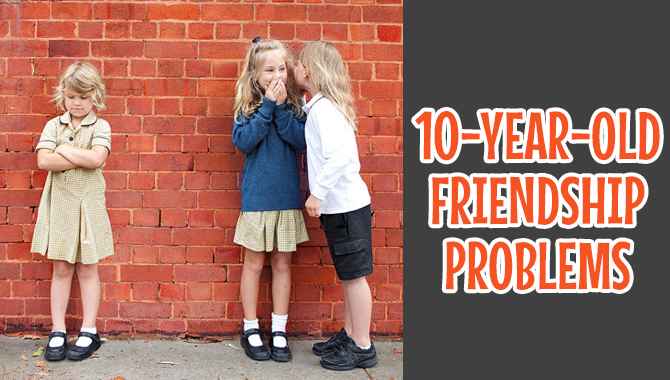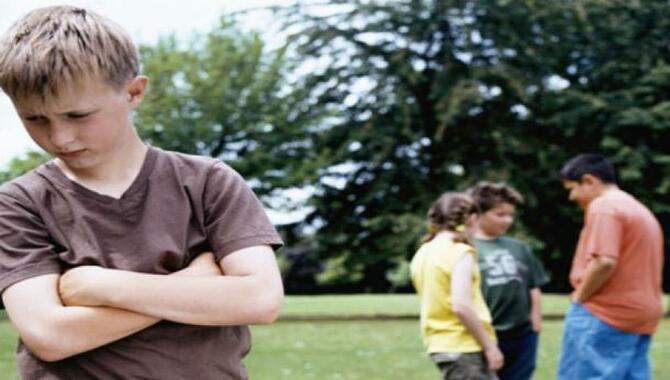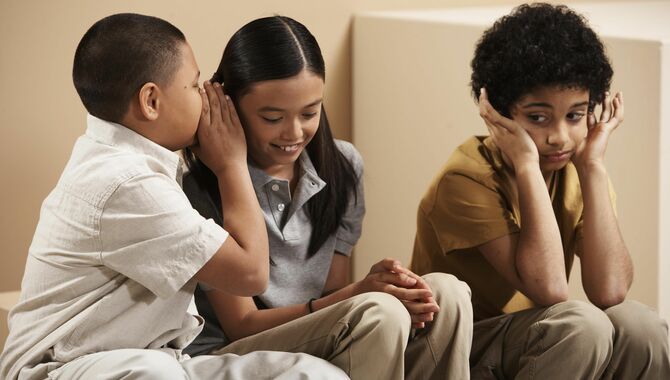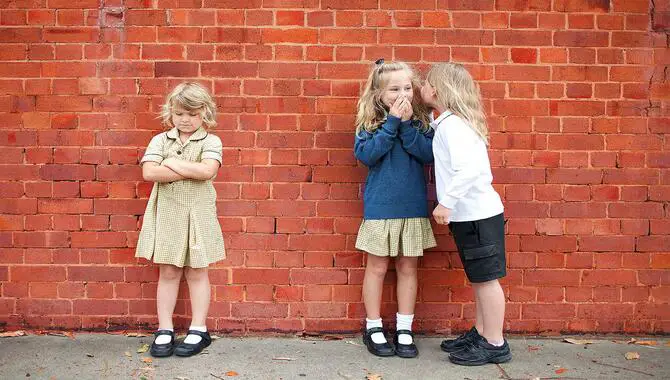It can be hard to know how to deal with difficult friendships. Even the closest of friends can start to fray sometimes, leading to hurt feelings, negative perceptions, and potentially even long-term problems.
But it’s not impossible to navigate these waters successfully. In this blog post, we’ll discuss 10-year-old friendship problems, the different types of friendship problems, their causes, and some tips on how to manage them. We’ll also provide a list of 10 common symptoms that may indicate that your child is struggling with a friendship problem. You can help your child get through this tough time in their life.

What Are Friendship Problems?

Friendship problems can be disagreements, conflicts, and tensions between friends. They’re often the result of incompatibility or differing interests. And while they may seem like trivial issues at first, these little disagreements can eventually snowball into big trouble.
10-Year-Old Friendship Problems – You Should Know

The 10-year age jump can be a confusing time for kids, leading to problems with their friendships. There are various types of friendship problems that can affect 10-year-olds.
Some of the most common issues kids include fighting, not talking to each other, and being too clingy or independent.
Examples include disagreements about responsibilities and sharing, hurt feelings, competition, and rivalry. It can be tough to know what to do when these problems arise, but it’s important to talk to your child about their concerns.
Tips For Managing Difficult Friendships
It’s hard when friendships change over time, but it’s important to talk to your child about it. This way, they’ll be better equipped to navigate difficult relationships. Along the way, be supportive and understanding. It can be tough for both of you, so offer guidance on things like talking about problems, listening, and compromising.
Above all, be there for them when they need you the most. 10-year-olds are capable of handling difficult friendships, but they need your help to do so. Here are a few tips to help manage difficult 10-year-old friendship problems:
1. Talk It Out
Talking about any issues brewing between your child and their friends is important. This can help resolve the problem quickly and prevent any further damage.
2. Don’t Take Things Personally
It’s common for kids to get upset when their friendships go wrong, but don’t take these conflicts too personally. They’re just trying to figure out who they are as individuals, and this process can sometimes be a little complicated!
3. Stay Positive And Supportive No Matter What
Encourage your child to stay positive and supportive of their friendships, even when things aren’t going well. This will help them feel supported and encouraged, which can greatly boost their morale.
4. Be A Good Role Model
Your child needs to have strong relationships with friends, but it’s also important that you lead by example! Set the right example of how to resolve conflicts and build healthy friendships. Modeling these skills will help your kids learn how to do it themselves down the road.
5. Don’t Expect Everything To Be Perfect
It’s natural to want things to go smoothly in friendships, but don’t let this expectation override the importance of good communication and healthy relationships.
6. Be Patient
Growing up is often a change process; sometimes, these changes can be difficult to navigate. Be Patient with your child as they try to figure out their way in the social world, and remember that mistakes are part of the learning process!
7. Be Understanding
It can be difficult to understand why friends are acting the way they are, especially when it feels like things have gone wrong. Try to be understanding and patient as your child tries to work through these issues.
8. Be Open To Discussing What Is Going On
If you feel like your child isn’t being transparent about their problems with their friends, be willing to discuss them openly and honestly. This can help you better understand why things are happening and figure out how to address the issues head-on.
9. Let Go Of Grudges
Sometimes it’s easy for us to hold onto old grudges against our friends, even if those relationships have ended recently or may never have been that great in the first place.
It’s important not to carry these grievances around unnecessarily; forgiving someone is a sign of strength and can help to heal the rift between you two.
Ten Common Symptoms Of A Friendship Problem In 10 Year-Olds

Children’s friendships are very important to them, and they will go to great lengths to maintain them. You see any of the following signs in your child, and It might be a sign that there is a friendship problem: withdrawing from family and friends, not wanting to do anything with them, and arguing a lot about little things. More here are 10 common symptoms of a friendship problem in 10-year-olds:
- Difficulty communicating effectively.
- Reduced social interaction.
- Increased isolation from friends and family members alike.
- A feeling of being left out or not included in activities with other kids their age that they used to enjoy participating in together.
5 Concerns about the relationship and what might happen if it ends.
- Repeatedly seeking reassurance that things are still good between them and their old friend, even when there may be little evidence to support this.
- Increased fighting or arguing with the person they used to consider a friend over minor issues or matters of no importance at all.
- A behavior change- often going from being friendly and outgoing to sulking, quiet, and withdrawing altogether- with little explanation as to why this might have happened.
9 Feel like they’re constantly missing out on something special because of the situation and feeling powerless to change it.
- A general feeling of not fitting in or not being good enough, no matter what they do.
6-Step Plan To Help Your Child Navigate Friendship Problems
 As parents, we know that our children are constantly growing and changing. They go through different stages, which can often be difficult for them.
As parents, we know that our children are constantly growing and changing. They go through different stages, which can often be difficult for them.
This is why it’s so important to help them healthily navigate their friendship problems. Here are six steps that will help your child learn how to make friends properly:
- Explain what friendship is and why it’s important.
- Help your child find friends that are a good fit for them based on their interests, personality, and values.
- Encourage social interaction with friends of all ages- even those who are troublemakers sometimes!
- Be there to support your child when one or more of their friends starts to deteriorate (whether this means being distant or behaving erratically).
- Communicate openly and frequently with both children about how they feel so that problems can address quickly and effectively.
- Keep a positive outlook and help your child believe that they can succeed in navigating their friendship problems.
Five Steps For Growing Healthy Friendships
It can be tough growing up and trying to build healthy friendships. That’s why starting is important by modeling healthy relationships for your child.
Make it a point to spend time together, even if the activities are simple. This will help the child learn how to communicate and resolve conflicts.
If you find that your child is having difficulty forming or maintaining friendships, be available to listen and provide guidance. Following these simple steps can help your child navigate these tricky waters and build healthy lifelong friendships.
Step 1. Get Your Child Thinking By Getting Their Input
Getting your child’s input on topics such as friendships is a great way to start them out of their comfort zones and encourage open communication.
By getting their thoughts down on paper, you can begin to make sense of the challenges they are facing and develop ways to address them.
It is also important that these conversations healthily take place – free from name-calling, gossiping, or arguing. This will help promote positive relationships among friends and family members alike.
Step 2. Teach New Skills Through Interactive Modeling
One way to teach new skills is by doing it through interactive modeling. This allows your child to learn fun and engaging, making the process easier for them.
Plus, it helps build their social skills as they navigate difficult situations together. It’s important not to give too much attention or rewards during this process – instead, focus on reinforcing positive behavior and helping them understand why certain things work well together.
After introducing new skills and activities like this, follow up with a discussion about how well your child handled the situation and what could be done next time such an issue arises.
Step 3. Practice To Grow Skills And Develop Habits
Helping your child to develop healthy friendships is an important step in the right direction. Practicing will help them learn how to communicate and interact with others effectively.
Fun activities like tag, hide-and-seek, and conversations can be great ways of doing this. Encouraging open communication is also a good idea – it’ll teach your child social skills and make friends easier for them in the future. As parents, we should model good behavior so that our children can learn from our mistakes.
Step 4. Support Your Child’s Development And Success
Encouraging healthy friendships is important for the development of children. Providing support and guidance will help your child develop positive relationships with others while setting rules will ensure that friends act appropriately and in a civilized manner.
It’s also crucial to let your child know that you are there for them no matter what, whether they’re experiencing challenges or making progress.
Helping them feel a sense of accomplishment when they make good friendships choices can be an encouraging message throughout their life.
Step 5. Recognize Effort And Quality To Foster Motivation
Regarding friends, parents and children need to be on the same page. This is where praising effort and not results come in handy. Instead of saying things like “you’re such a good friend” or “I’m glad you’re my friend,” try something more specific like, “Thank you for working so hard today.”
This way, your child can see that making an effort is rewarded – which will encourage them to keep up the good work. Besides being motivating, this approach also helps build healthy friendship habits from a young age. Doing things together becomes special instead of routine – fostering strong ties long into adulthood.
Conclusion
Friendship problems can be difficult for both children and parents to deal with. However, with the help of these tips, your child will be able to navigate these challenging times with ease.
Understanding 10-year-old friendship problems, the different types of friendship problems, and their symptoms. You can help your child to identify and resolve the issues as early as possible. Thank you for reading, and we hope these tips have helped.
Frequently Asked Questions
What Should I Do If My Child Is Struggling With Their Friendships?
It’s important to be supportive and encourage your child while setting boundaries. It may take time for them to develop good relationships, but they can eventually achieve success with patience and support.
If you feel like a problem needs addressing immediately, talk to your pediatrician or therapist. They can guide how best to help your child navigate these tricky waters.
What Should I Do If My Child Is Not Getting Along With Their Friends?
There are a few things that you can do to help your child get along better with their friends. First, be supportive of their activities and interests – this will show them that you believe in them and make them more likely to enjoy spending time together.
Secondly, set rules for how the friendship should behave – this way, your child knows what to expect of them, and there are boundaries both parties can understand. Finally, praise effort – instead of saying things like “you’re such a good friend”.
How Many Friends Should A 10-Year-Old Have?
A healthy number of friends for a 10-year-old is between three and five. This allows your child to feel secure and happy without feeling too lonely or insecure.
Additionally, they must spend time with their close friends regularly to develop strong emotional connections. Therefore, encourage your child to make friends easily without extra effort.
Also, don’t be overly critical about their friendships; let them figure things out for themselves. Lastly, tell your child that spending time with others is just as important as spending time with their closest friends.
Is It Ever Okay For A Child To Break Up With A Friend?
It’s never okay for a child to break up with a friend, but that doesn’t mean they can’t experience tough times regarding their friendship.
A child should always have honest and open communication with one another about how they’re feeling. If one of the friends is experiencing a lot of pain or sadness and the other friend isn’t being supportive, then the friendship might be at risk. In these cases, it may be time for you or another adult to figure out what needs to be done.
Should My 10-Year-Old Have A Best Friend?
Yes, children need strong relationships – friendship is integral to growing up. However, not all friendships will be easy – sometimes, they will be hard and challenging.
Some kids find that their best friend is the one who understands them the best and has been there for them through thick and thin.
If your child is struggling with friendship problems and you feel like they need some extra support, don’t hesitate to seek help from a professional or parent group.

I’m a writer and blogger who loves to talk about entertainment, culture, and relationships. I love to share my thoughts and insights on these topics, and I’m always looking for new ways to engage with my readers. I’m also a big fan of learning new things, so I’m always exploring new areas of interest.
